Conímbriga Roman Ruins & Museum provides a captivating glimpse into ancient Lusitânia’s past. Situated just 16 kilometers from Coimbra, Portugal, this archaeological site dates back to 139 BC. Visitors can explore well-preserved structures like the Roman Forum and opulent manor houses adorned with stunning mosaics. The onsite Monographic Museum houses artifacts that reflect the city’s role as a vital hub in Roman economic networks. Whether exploring on their own or with a guided tour, travelers uncover the remarkable history and significance of this ancient Roman gem.
Key Points
- Conímbriga was an ancient capital of Lusitânia established in 139 BC, offering insights into daily life under Roman rule.
- The site features well-preserved remains of a Roman Forum, lavish manor houses, and stunning mosaics and frescoes.
- Excavations have revealed artifacts reflecting the routines and domestic life of the community, complementing the grand structures.
- Conímbriga’s strategic location along key regional trade routes made it an important hub for the exchange of goods and cultural influences.
- Personalized guided tours are available for deeper exploration of the Roman ruins and the Monographic Museum, providing insights into the site’s history and significance.
Discovering Conímbriga: Ancient Roman Gem
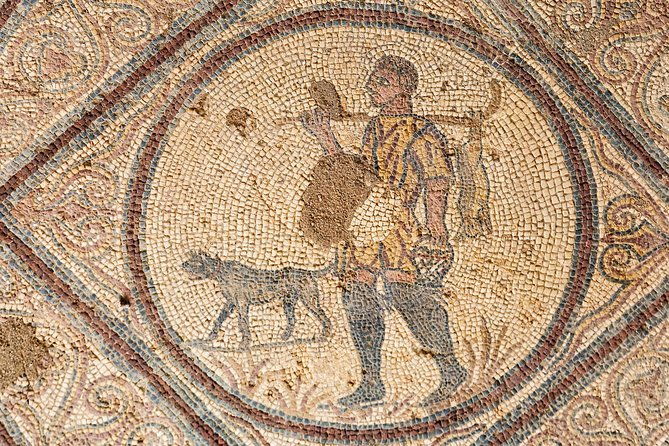
Although the Roman ruins of Conímbriga sit just 16 kilometers from Coimbra, Portugal, their significance as an ancient capital of Lusitânia is truly remarkable.
Established in 139 BC, the once-thriving city offers a captivating glimpse into daily life under Roman rule. Visitors can explore the remains of ornate manor houses, the impressive Roman Forum, and the intriguing Domus.
The on-site Monographic Museum showcases a treasure trove of small artifacts, providing comprehensive insights into Conímbriga’s role in regional trade routes.
With private guided tours available, travelers can delve deeper into this captivating ancient Roman gem.
Museum hopping your thing? Check out these other cultural spots we've reviewed in Coimbra
Exploring the Architectural Wonders
One of the most captivating aspects of Conímbriga is its well-preserved architectural wonders.
Visitors can explore the remarkably intact Roman Forum, a testament to the city’s former grandeur. The Domus, or manor houses, offer a glimpse into the lavish lifestyles of the wealthy elite, with stunning mosaics and frescoes adorning the floors and walls.
The intricate network of roads, aqueducts, and public baths further showcase the advanced engineering prowess of the Romans.
These architectural marvels provide a tangible connection to the past, allowing visitors to enjoy the history and daily life of this ancient Roman settlement.
Unearthing Daily Life in the Roman Province
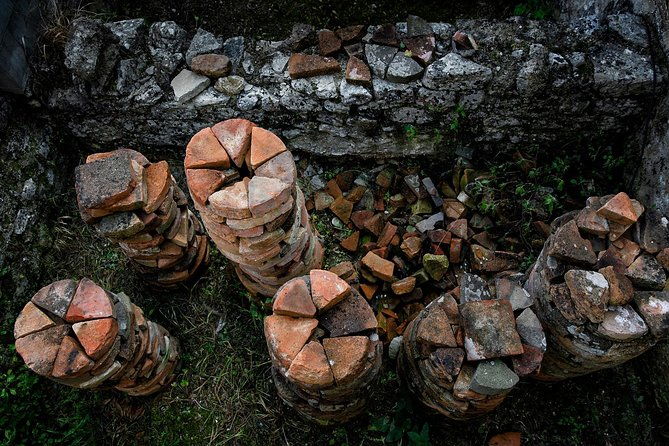
Beyond the architectural marvels of Conímbriga, the Roman ruins also offer a window into the daily lives of its inhabitants. Excavations have uncovered artifacts that provide insights into the routines and activities of the province’s population. A glimpse into their domestic life can be seen through the well-preserved remains of manor houses and the Domus, or family homes. Plus, the discovery of small items like pottery, kitchenware, and jewelry offer a tangible connection to the people who once walked these streets. Conímbriga’s Roman past is not just a story of grand structures, but also of the everyday lives that shaped this ancient community.
| Feature | Description |
|---|---|
| Manor Houses | Remains of luxurious private residences |
| Domus | Well-preserved family homes |
| Pottery | Utilitarian and decorative ceramics |
| Kitchenware | Tools and implements used for cooking and dining |
Role of Conímbriga in Regional Trade Routes
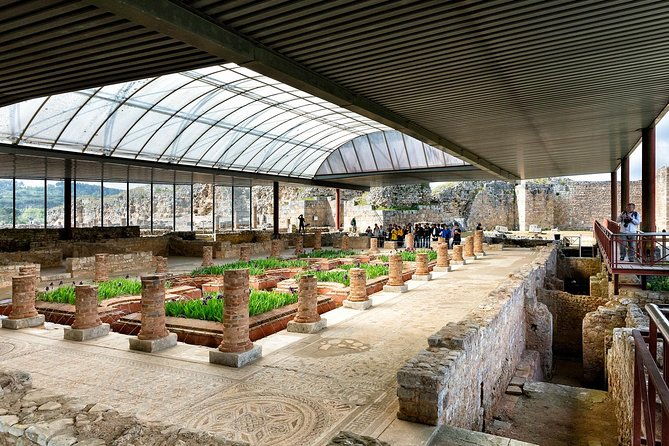
Conímbriga’s strategic location along key regional trade routes played a vital role in its prosperity during the Roman era.
As the capital of the Roman province of Lusitânia, the city served as a hub for the exchange of goods, ideas, and cultural influences. Merchants traversed well-developed roads connecting Conímbriga to ports and other urban centers, facilitating the flow of valuable commodities like olive oil, wine, and ceramics.
This commercial activity generated wealth, which in turn funded the construction of grand public buildings and the development of a thriving local economy.
Conímbriga’s central position made it an important node in the intricate web of Roman trade networks across the Iberian Peninsula.
Guided Tour Experiences: Personalized Insights
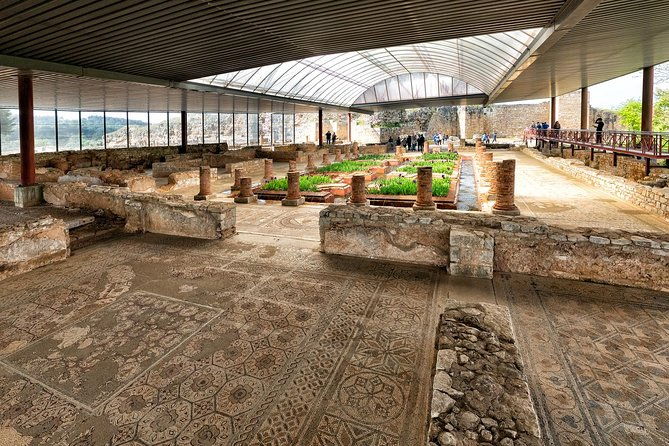
Visitors to Conímbriga can choose from personalized guided tour experiences that offer a deeper understanding of the ancient Roman ruins.
Tour options include:
- Morning or afternoon excursions to explore the site at your preferred time.
- Private guides who provide comprehensive insights into daily life under Roman rule.
- Engaging narratives that highlight the role of Conímbriga in regional trade routes.
- Refreshments, including coffee, tea, snacks, and even alcoholic beverages, to enhance the tour experience.
These tailored tours provide an immersive and informative exploration of this remarkable archaeological treasure.
Tour Inclusions and Amenities
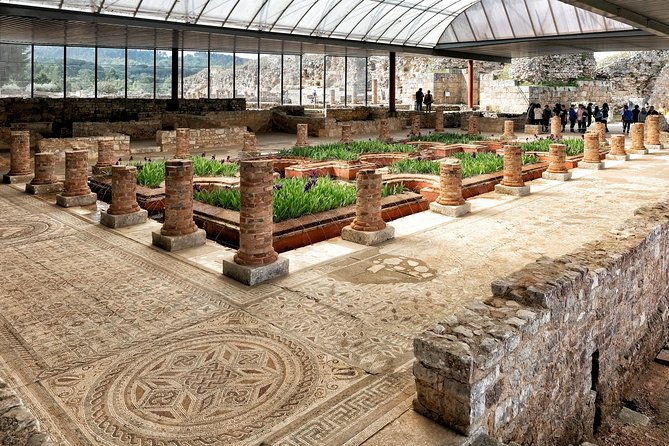
Along With the personalized guided experiences, tours of Conímbriga include an air-conditioned vehicle as well as all applicable fees and taxes.
Refreshments like coffee, tea, soda, and even alcoholic beverages are provided throughout the tour. These amenities ensure visitors’ comfort and convenience as they explore the ancient Roman ruins.
The tours are suitable for most travelers, though they’re not recommended for those with serious medical conditions.
With a location near public transportation, the Conímbriga site is easily accessible for those looking to enjoy Portugal’s rich history.
Accessibility and Participation
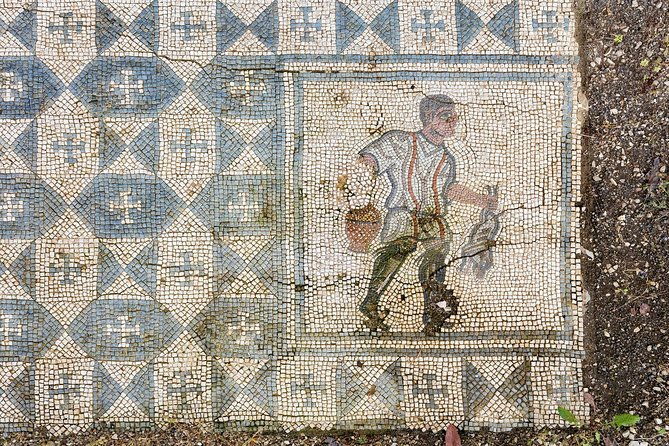
While the Conímbriga Roman ruins aren’t wheelchair accessible, the site is situated near public transportation, making it easily reachable for most travelers.
Visitors should keep a few things in mind when planning their visit:
-
The ruins feature uneven terrain and cobblestone paths, which may be challenging for those with mobility issues.
-
Guided tours aren’t recommended for individuals with serious medical conditions, as the tour may involve extended walking and standing.
-
Visitors are advised to wear comfortable shoes and bring water, as the site can be exposed to the elements.
-
Children are welcome, but parental supervision is required.
Traveler Reviews and Feedback
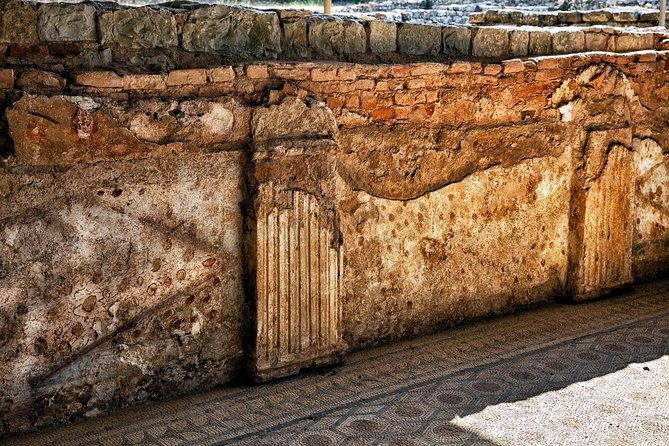
Travelers have provided overwhelmingly positive reviews for the Conímbriga Roman ruins, praising the knowledgeable guides and the site’s historical significance.
With an average rating of 4.6 stars from 26 reviews, visitors highlight the comprehensive insights into daily life under Roman rule and the province’s role in trade routes.
One reviewer called it an "extremely interesting site for history buffs," while another praised the "wonderful experience with a patient guide."
Ask Away
What Are the Entry Fees for the Conímbriga Site?
The entry fees for the Conímbriga site are not explicitly mentioned in the provided information. The tours include all fees and taxes, suggesting the admission price is covered within the tour package.
Is Photography Allowed Inside the Museum and Ruins?
Photography is generally allowed at the Conímbriga site and museum, though visitors should check for any temporary restrictions. Visitors are encouraged to capture the stunning Roman ruins and artifacts to document their visit.
Are Guided Tours Offered in Languages Other Than English?
Guided tours at Conímbriga are offered in several languages beyond English, including Portuguese, Spanish, and French. Visitors can inquire about language options when booking their tour to ensure they receive a personalized experience in their preferred language.
Are There Any Discounts Available for Senior Citizens or Students?
The tours don’t currently offer discounts for seniors or students, but they may consider implementing them in the future to make the experience more accessible. Visitors should check the tour provider’s website or inquire directly about any potential discounts.
Can Visitors Bring Their Own Food and Drinks to the Site?
Visitors are generally allowed to bring their own food and non-alcoholic drinks to the site. However, the on-site cafeteria offers refreshments for purchase. Visitors should check the site’s policies before arriving to ensure they comply with any restrictions.
Final Words
Conímbriga’s Roman ruins and museum offer a captivating window into Lusitânia’s past. Visitors can explore well-preserved structures, uncover artifacts from daily life, and learn about the city’s role in regional trade. Guided tours provide personalized insights, enhancing the experience. With accessibility and positive traveler reviews, Conímbriga is a must-visit destination for those interested in Roman history and archaeology.
More Tours in Coimbra
- The Beautiful Story of Coimbra:Guided Tour/ Tastings&Tickets
- Aveiro and Coimbra private tour from Porto
- Coimbra Cathedral Guided Tour
- Coimbra: Private & Flexible Walking Tour in Historic Center
- Tour from Lisbon: Aveiro, Coimbra, Conímbriga, and the Palace of Bussaco
- Coimbra: guided tour with a cinematic perspective
More Tour Reviews in Coimbra
- The Beautiful Story of Coimbra:Guided Tour/ Tastings&Tickets
- Aveiro and Coimbra private tour from Porto
- Coimbra Cathedral Guided Tour
- Coimbra: Private & Flexible Walking Tour in Historic Center
- Tour from Lisbon: Aveiro, Coimbra, Conímbriga, and the Palace of Bussaco
- From Coimbra: Serra da Estrela Natural Park Day Trip
Still browsing? Here are more Coimbra experiences we've covered recently
- 14 Top Tours In Coimbra (With Reviews & Prices)
- 5 Best Walking Tours In Coimbra (With Reviews & Prices)
- The 14 Most Popular Tours & Experiences In Coimbra
- The Beautiful Story of Coimbra:Guided Tour/ Tastings&Tickets
- Aveiro and Coimbra private tour from Porto
- Coimbra Cathedral Guided Tour
- Coimbra: Private & Flexible Walking Tour in Historic Center
- Tour from Lisbon: Aveiro, Coimbra, Conímbriga, and the Palace of Bussaco
- From Coimbra: Serra da Estrela Natural Park Day Trip
- Coimbra – Condeixa: 60-minute Off-road Buggy Adventure
- From Coimbra: Cycling on the Vouga Eco-Trail
- Coimbra – Condeixa: 180-minute Off-road Buggy Adventure
